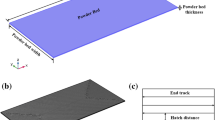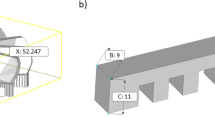Abstract
3D printing has offered cost-effective, lightweight, and complex parts. To extend their applications, 3D printed parts need to be welded in order to form the larger functional assemblies. For this purpose, Laser Transmission Welding (LTW) is a promising joining technology. This paper aims to investigate the light scattering effect on the intensity profile of the laser heat source during the transmission through the 3D printed laser-transparent part. Indeed, the inherent design of the 3D printing technology results in a complex heterogeneous microstructure with a significant amount of porosity inside the printed parts. Such structure induces the optical diffusion (i.e. light scattering) of the laser beam within the 3D printed parts. This phenomenon leads to the reduction of the transmitted energy arriving at the weld interface, which directly influences the quality of the joint and its mechanical performance. The approach adopted in this paper is to propose a ray-tracing model to simulate the optical paths of the laser beam through the 3D printed laser-transparent part, which is able to evaluate changes in the laser heat source at the weld interface directly linked with the light scattering effect within the microstructure of the parts. Experimental measurements are performed to assess the transmitted intensity flux distribution using an image processing technique, instrumented with a digital camera and macro lens. The numerical results show good accordance with the experimental one, which proves the confidence of the proposed ray-tracing model. Finally, 3D transient thermal model of the LTW process is performed using the FEM software COMSOL Multiphysic® to confirm the influence of the scattering effect on the temperature field and thus on the quality of the weld.

















Similar content being viewed by others
References
Kabir SMF, Mathur K, Seyam A-FM (2020) A critical review on 3D printed continuous fiber-reinforced composites: History, mechanism, materials and properties. Composite Structures 232:111476. https://doi.org/10.1016/j.compstruct.2019.111476. Accessed 19 Oct 2022
Le A-D, Cosson B, Asséko ACA (2021) Simulation of large-scale additive manufacturing process with a single-phase level set method: a process parameters study. The Int J Adv Manufact Technol 113(11):3343–3360. https://doi.org/10.1007/s00170-021-06703-5. Accessed 27 July 2022
Werken N, Tekinalp H, Khanbolouki P, Ozcan S, Williams A, Tehrani M (2020) Additively manufactured carbon fiber-reinforced composites: State of the art and perspective. Additive Manufacturing 31:100962. https://doi.org/10.1016/j.addma.2019.100962. Accessed 12 April 2022
Chacón JM, Caminero MA, García-Plaza E, Núñez PJ (2017) Additive manufacturing of PLA structures using fused deposition modelling: Effect of process parameters on mechanical properties and their optimal selection. Materials & Design 124:143–157. https://doi.org/10.1016/j.matdes.2017.03.065. Accessed 21 Sept 2022
Tian X, Liu T, Yang C, Wang Q, Li D (2016) Interface and performance of 3D printed continuous carbon fiber reinforced PLA composites. Compos A: Appl Sci Manuf 88:198–205. https://doi.org/10.1016/j.compositesa.2016.05.032. Accessed 28 April 2022
Zhang Z, Yavas D, Liu Q, Wu D (2021) Effect of build orientation and raster pattern on the fracture behavior of carbon fiber reinforced polymer composites fabricated by additive manufacturing. Additive Manufacturing 47:102204. https://doi.org/10.1016/j.addma.2021.102204. Accessed 12 April 2022
Berger S, Oefele F, Schmidt M (2015) Laser transmission welding of carbon fiber reinforced thermoplastic using filler material-A fundamental study. Journal of Laser Applications 27(S2):29009. https://doi.org/10.2351/1.4906391. Publisher: Laser Institute of America. Accessed 28 Feb 2023
Akué Asséko AC, Cosson B, Schmidt F, Le Maoult Y, Gilblas R, Lafranche E (2015) Laser transmission welding of composites - Part B: Experimental validation of numerical model. Infrared Physics & Technology 73:304–311. https://doi.org/10.1016/j.infrared.2015.10.005
Chabert F, Garnier C, Sangleboeuf J, Akue Asseko AC, Cosson B (2020) Transmission laser welding of polyamides: effect of process parameter and material properties on the weld strength. Procedia Manufacturing 47:962–968. https://doi.org/10.1016/j.promfg.2020.04.297
Le A-D, Akué Asséko AC, Nguyen T-H-X, Cosson B (2023) Laser intensity and surface distribution identification at weld interface during laser transmission welding of thermoplastic polymers: A combined numerical inverse method and experimental temperature measurement approach. Polymer Engineering & Science. https://doi.org/10.1002/pen.26405
Ilie M, Kneip J-C, Matteï S, Nichici A, Roze C, Girasole T (2007) Laser beam scattering effects in non-absorbent inhomogenous polymers. Optics Lasers Eng 45(3):405–412. https://doi.org/10.1016/j.optlaseng.2006.07.004. Accessed 05 June 2023
Akué Asséko AC, Cosson B, Deleglise M, Schmidt F, Le Maoult Y, Lafranche E (2015) Analytical and numerical modeling of light scattering in composite transmission laser welding process. Int J Mater Form 8(1):127–135. https://doi.org/10.1007/s12289-013-1154-7
Chen M, Zak G, Bates PJ (2013) Description of transmitted energy during laser transmission welding of polymers. Welding in the World 57(2):171–178. https://doi.org/10.1007/s40194-012-0003-5. Accessed 20 July 2022
Xu XF, Parkinson A, Bates PJ, Zak G (2015) Effect of part thickness, glass fiber and crystallinity on light scattering during laser transmission welding of thermoplastics. Optics & Laser Technology 75:123–131. https://doi.org/10.1016/j.optlastec.2015.06.026. Accessed 09 May 2022
Zak G, Mayboudi L, Chen M, Bates PJ, Birk M (2010) Weld line transverse energy density distribution measurement in laser transmission welding of thermoplastics. J Mater Process Technol 210(1):24–31. https://doi.org/10.1016/j.jmatprotec.2009.08.025. Accessed 09 May 2022
Kuklik J, Mente T, Wippo V, Jaeschke P, Kaierle S, Overmeyer L (2022) Enabling laser transmission welding of additively manufactured thermoplastic parts using an expert system based on neural networks. Journal of Laser Applications 34(4):042022. https://doi.org/10.2351/7.0000787. Publisher: Laser Institute of America. Accessed 25 Oct 2022
Kuklik J, Mente T, Wippo V, Jaeschke P, Kuester B, Stonis M, Kaierle S, Overmeyer L (2022) Laser welding of additively manufactured thermoplastic components assisted by a neural network-based expert system, vol 11994, pp 119–124. SPIE. https://doi.org/10.1117/12.2609365
Cosson B, Akué Asséko AC, Dauphin M (2018) A non-destructive optical experimental method to predict extinction coefficient of glass fibre-reinforced thermoplastic composites. Optics & Laser Technology 106:215–221. https://doi.org/10.1016/j.optlastec.2018.04.009. Accessed 09 Mar 2022
Cosson B, Akué Asséko AC, Lagardère M, Dauphin M (2019) 3D modeling of thermoplastic composites laser welding process - A ray tracing method coupled with finite element method. Optics & Laser Technology 119:105585. https://doi.org/10.1016/j.optlastec.2019.105585. Accessed 18 May 2022
Cosson B, Deléglise M, Knapp W (2015) Numerical analysis of thermoplastic composites laser welding using ray tracing method. Composites Part B: Engineering 68:85–91. https://doi.org/10.1016/j.compositesb.2014.08.028. Accessed 18 May 2022
Gao X, Qi S, Kuang X, Su Y, Li J, Wang D (2021) Fused filament fabrication of polymer materials: A review of interlayer bond. Additive Manufacturing 37:101658. https://doi.org/10.1016/j.addma.2020.101658. Accessed 13 May 2022
Gao X, Qi S, Zhang D, Su Y, Wang D (2020) The role of poly (ethylene glycol) on crystallization, interlayer bond and mechanical performance of polylactide parts fabricated by fused filament fabrication. Additive Manufacturing 35:101414. https://doi.org/10.1016/j.addma.2020.101414 . Accessed 13-05-2022
Ghorbani J, Koirala P, Shen Y-L, Tehrani M (2022) Eliminating voids and reducing mechanical anisotropy in fused filament fabrication parts by adjusting the filament extrusion rate. J Manuf Process 80:651–658. https://doi.org/10.1016/j.jmapro.2022.06.026. Accessed 28 June 2022
Le A-D, Gilblas R, Lucin V, Maoult YL, Schmidt F (2022) Infrared heating modeling of recycled PET preforms in injection stretch blow molding process. Int J Therm Sci 181:107762. https://doi.org/10.1016/j.ijthermalsci.2022.107762. Accessed 28 Feb 2023
An Y, Myung JH, Yoon J, Yu W-R (2022) Three-dimensional printing of continuous carbon fiber-reinforced polymer composites via in-situ pin-assisted melt impregnation. Additive Manufacturing 55:102860. https://doi.org/10.1016/j.addma.2022.102860. Accessed 13 May 2022
Acknowledgements
The authors extend their sincere appreciation to the National French Research Agency’s ANR JCJC program for funding the SHORYUKEN project (Grant agreement n\(^\circ \) ANR-21-CE10-0007-01) through the AAPG 2021-CE10 “Industrie et Usine du Futur: Homme, Organisation, Technologies” initiative. Without their support, this work would not have been possible.
Author information
Authors and Affiliations
Corresponding author
Ethics declarations
Conflict of Interests
The authors declare no conflict of interest.
Additional information
Publisher's Note
Springer Nature remains neutral with regard to jurisdictional claims in published maps and institutional affiliations.
Benoît Cosson and André Chateau Akué Asséko contributed equally to this work.
Rights and permissions
Springer Nature or its licensor (e.g. a society or other partner) holds exclusive rights to this article under a publishing agreement with the author(s) or other rightsholder(s); author self-archiving of the accepted manuscript version of this article is solely governed by the terms of such publishing agreement and applicable law.
About this article
Cite this article
Anh-Duc, L., Cosson, B. & Akué Asséko, A.C. Investigation of the effect of light scattering on transmitted laser intensity at the weld interface during laser transmission welding of 3D printed thermoplastic parts. Int J Mater Form 16, 65 (2023). https://doi.org/10.1007/s12289-023-01786-9
Received:
Accepted:
Published:
DOI: https://doi.org/10.1007/s12289-023-01786-9




